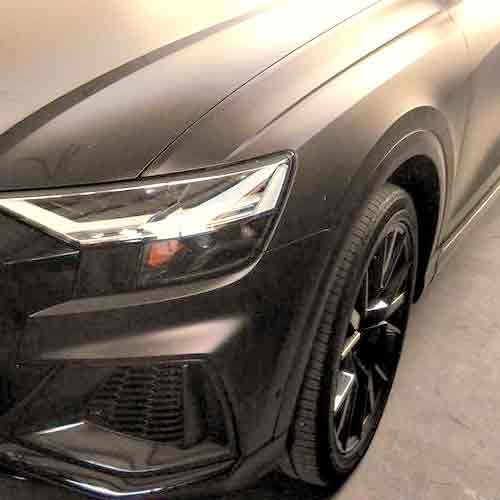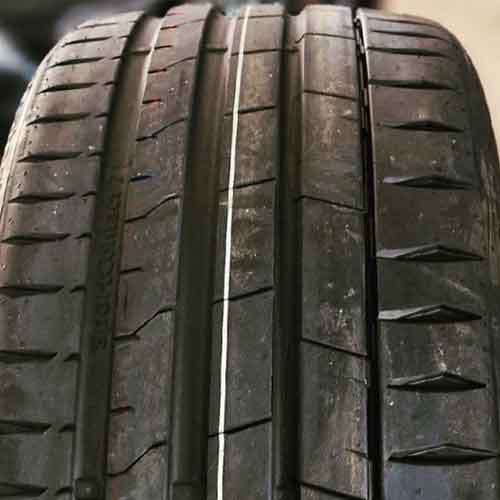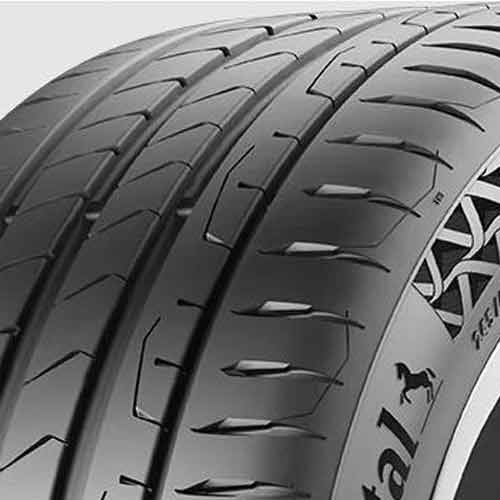Both the Continental SportContact 7 and the Continental PremiumContact 7, although come from the same manufacturer and category here, are very different. Let me tell you what I mean.

Choosing between these two comes down to identifying what aspects are more vital for your driving experience. Meaning, the SportContact 7 slightly edges out with marginally better dry braking, and excels in wet braking and aquaplaning resistance, combined with improved dry handling and fuel economy. On the other hand, the PremiumContact 7 shines in terms of offering a quieter ride and being more pocket-friendly, alongside better control during wet handling. Hence, your choice would pivot on whether you prefer a more performance-oriented ride with the SportContact 7, or a comfortable and economical experience with the PremiumContact 7.
Table of Contents
Tread Design
Continental SportContact 7 comes with an asymmetric tread pattern, just like its bigger brother.

In the middle (apart from shoulders, I mean), you will find that 3 ribs form four distinct longitudinal channels of varying widths, with the furthest right channel exhibiting the slimmest profile.
Additionally, these ribs maintain a continuous pattern, fortified by a secondary layer of rubber beneath them, thereby promising superior directional grip on arid road surfaces.
Whereas for wet traction, the tire offers an array of cuts and sipes, crafted in various configurations and angles, ensuring optimum traction.
Moving towards shoulders, here lugs are seen with pronounced and bold nature, where solid cuts are seen.
These in-groove notches (if you will), facilitate significant lateral G-forces, promising an epic handling capabilities.
On the other side, the Continental PremiumContact 7 is distinguished by its asymmetric pattern too, where similar 5 rib design is seen.

Let’s start form its shoulders, where the overall pattern is more aggressive in comparison.
I mean look at those biting cuts.
These thick slits serve as more powerful in-groove notches, ensuring a slightly more optimal wet and dry traction, mostly enhancing handling dynamics (since shoulders are responsible for that).
Moreover, the tire’s central ribs are also more biting, where you see a series of cuts/siping pointing towards various angles.
These basically allow for a more competitive wet traction, as seen by the tire’s braking distance and acceleration efficacy.
Road Comfort Assessment
Two dimensions are judged when it comes to overall ride comfort. One, how well the tire dampens down the nosie, and two, how well its able to mitigate the road vibrations.
Let’s discuss them both.
Tire Noise Generation
A significant contributing factor to a vehicle’s overall comfort is the level of noise generated by the tires.
This noise, fundamentally influenced by air particles hitting the tread walls, can greatly impact the overall driving experience.
Air mostly comes in through shoulders, and hit the walls around, creating noise, which then echos a little bit, further enhancing the noise pollution.
Having said that, in this regard, the Continental PremiumContact 7 presents a better overall efficacy.
Its smaller tread voids minimize the space wherein air particles can bounce around, reducing the consequent noise generated. And its tread is not as susceptible to in-groove resonance too (which is essentially the echoing of the sound waves).
On the other hand, the Continental SportContact 7, while hosting more voided shoulders allow more air to get in. So despite the tire’s great pitch sequencing technology, it still gets to be louder here.
(This technology, if you are wondering, basically create different or varying tones, throughout the trad, so those try to cancel out each other frequencies, thereby reducing noise levels).
Road Vibrations
The level of vibration experienced during a drive is fundamentally influenced by the tire’s ability to absorb irregularities on the road.
And here, a tire’s composition, both internally and externally, plays a pivotal role.
Why you ask?
Well, because in general, tires with softer constructions offer a smoother ride as they can absorb bumps more effectively.
Unfortunately, the Continental SportContact 7 faces some limitations here due to its harder tread compound and less flexible internal cap plies, which potentially result in a less cushioned ride on uneven terrains.
Though keep in mind, its all subjective, so things may vary here a little bit.
Fuel Consumption
Fuel efficiency remains a critical concern with increasing gas prices. And here fuel efficient tires usually have low rolling resistance values, a factor which is highly dependent on the tire’s tread compound and weight.
In this regard, the Continental SportContact 7 slightly edges out, showcasing an optimized structure characterized by shallower average tread depth and a lighter overall structure.
Basically with shallower tread depth, and a stiffer compound, lugs aren’t that susceptible to moving/flexing, and so less energy is used up in the deformation of the tread, and more is consumed in to the rolling of the tire as a whole.
The PremiumContact 7, therefore with greater tread voids especially towards the shoulders, lacks behind, where its greater weight isn’t helping either.
(More weight means more pressure on the tread, and greater rolling resistance).
Tread Life
When it comes to tire longevity, a fine balance between tread depth and composition plays a critical role. So to put things in to perspective, tires with a deeper tread depth are subjected to slower wear rates, while those fabricated with stiffer materials resist quicker tread degradation, which is an obvious one.
Now, here, the Continental PremiumContact 7 shines as a superior choice, where it gives you a more durable rubber composition that is resilient against rapid wear.
Moreover, its slightly deeper tread depth also ensures a prolonged lifespan, delaying the time it takes to reach the legal tread depth limit, and thus providing better value over time.
But keep in mind that both tires don’t have any tread wear warranties.
Dry Performance Analysis
To accurately assess the performance of these tires under dry conditions, we need to take a deep dive into aspects such as braking abilities, acceleration proficiency, and the adeptness in navigating corners.
Straight-line Traction
Understanding the concept of ‘dry grip’ or straight-line traction requires a deep dive into the directional grip that tires provide. This is a pivotal metric that heavily influences the tire’s ability to stop effectively on dry surfaces.
And out of both tires, the Continental SportContact 7 takes a noteworthy lead in this sector.
According to extensive tests conducted by me and my team, it exhibits shorter braking distances by an average of 4 feet.
And the primary reason for this commendable performance is the enhanced contact it maintains with the road, particularly in the central tread area, where the majority of the weight is concentrated during straight-line movements.
In comparison, the PremiumContact 7 falls a tad short due to the presence of numerous notches and sipes that slightly compromise its road contact, and consequently its braking efficacy. Basically it has more tread features, that eat away the rubber, that could have been in contact with the road instead.
Dry Handling
When maneuvering through twists and turns, the performance of the tire’s edges, which are the shoulders and sidewalls, becomes crucial.
The reason for this lies in the physics of inertia and the resulting centripetal force, which shifts the weight towards the edges during cornering.
In this regard, the SportContact 7 shows up with better lateral traction values (calculated by g forces). The tire offers superior contact with the road from shoulders, where the rubber meets the surface more firmly.
This stable connection translates in to a better under and over steering balance, resulting in faster and more responsive handling.
In contrast, while the PremiumContact 7 does offer good enough performance as well, it cannot quite match the stellar handling capabilities of the SportContact 7, particularly in dry conditions.
Performance on Wet Traction
Ensuring safety and reliability during wet conditions necessitates a tire that can provide a strong grip and resist hydroplaning effectively.
Here, grooves play an instrumental role in combating hydroplaning, clearing water at a macro level, while the sipes handle the residual moisture, absorbing water particles and allowing the rubber to maintain a strong grip on the road.
Now speaking of both tires, we get to see some mixed results here.
The SportContact 7 impresses with its wet braking capabilities and slightly superior handling times, thanks to a higher number of sipes and a flexible rubber compound. However, it doesn’t quite match up to its competitor when it comes to hydroplaning resistance.
Although not the top performer in its category, the PremiumContact 7 does offer more efficient water clearance, particularly on its outer lugs, ensuring a safer ride (and turns) in wet conditions.
Take Home Points
In evaluating the performance of both tires, various aspects were observed.
The Continental PremiumContact 7 offers a quieter and a more comfortable ride in comparison.
Moreover, the tire stands out in tread life, where it gives you a more durable rubber composition and deeper tread depth that promises a longer lifespan
Though in terms of fuel consumption, the SportContact 7 leads with a structure optimized for low rolling resistance.
What else? Yes, in dry conditions, the SportContact 7 distinctly outshines with better straight-line traction and handling capabilities. However, when it comes to wet traction, the tire is although better in wet braking and handling but lacks in hydroplaning resistance.